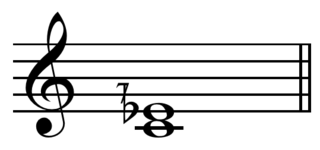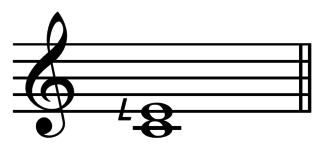 W
W7-limit or septimal tunings and intervals are musical instrument tunings that have a limit of seven: the largest prime factor contained in the interval ratios between pitches is seven. Thus, for example, 50:49 is a 7-limit interval, but 14:11 is not.
 W
WThe harmonic seventh interval Play (help·info), also known as the septimal minor seventh, or subminor seventh, is one with an exact 7:4 ratio. This is somewhat narrower than and is, "particularly sweet," "sweeter in quality" than an "ordinary" Just minor seventh, which has an intonation ratio of 9:5.
 W
WThe Magic Chord is a chord and installation (1984) created by La Monte Young, consisting of the pitches E, F, A, B♭, D, E, G, and A, in ascending order and used in works including his The Well-Tuned Piano and Chronos Kristalla (1990). The latter was performed by the Kronos Quartet and features all notes of the magic chord as harmonics on open strings. The quartet has been described as, "offer[ing] perhaps the ultimate challenge in performing in a just environment."
 W
WIn music and tuning, the ragisma is an interval with the ratio of 4375:4374, ≈0.396 cents. It is usually defined as the difference between the septimal minor third (7:6) and two Bohlen–Pierce small semitones. It is also the difference between minor Bohlen–Pierce diesis (245:243) and septimal semicomma (126:125), as well as the difference between the septimal third tone (28:27) and the greater diesis (648:625).
 W
WIn music, a septimal chromatic semitone or minor semitone is the interval 21:20. It is about 84.47 cents. The septimal chromatic semitone may be derived from the harmonic series as the interval between the twentieth and twenty-first harmonics.
 W
WA septimal comma is a small musical interval in just intonation that contains the number seven in its prime factorization. There is more than one such interval, so the term septimal comma is ambiguous, but it most commonly refers to the interval 64/63. Play (help·info)
 W
WIn music, a septimal diatonic semitone is the interval 15:14 Play (help·info). It is about 119.44 cents. The septimal diatonic semitone may be derived from the harmonic series as the interval between the fourteenth and fifteenth harmonics.
 W
WIn music, septimal diesis is an interval with the ratio of 49:48 play (help·info), which is the difference between the septimal whole tone and the septimal minor third. It is about 35.7 cents wide, which is narrower than a quarter-tone but wider than the septimal comma. It may also be the ratio 36:35, or 48.77 cents. Play (help·info)
 W
WIn music, the ratio 225/224 is called the septimal kleisma (play (help·info)). It is a minute comma type interval of approximately 7.7 cents. Factoring it into primes gives 2−5 32 52 7−1, which can be rewritten 2−1 (5/4)2 (9/7). That says that it is the amount that two major thirds of 5/4 and a septimal major third, or supermajor third, of 9/7 exceeds the octave. If the septimal kleisma is tempered out, as it is for instance in miracle temperament, septimal meantone temperament, septimal magic temperament and in many equal temperaments, for example 12, 19, 22, 31, 41, 53, 72 or 84 equal, then an augmented triad consisting of two major thirds and a supermajor third making up an octave becomes possible. The existence of such a chord, which might be termed the septimal kleisma augmented triad, is a significant feature of a tuning system.
 W
WIn music, the septimal major third play (help·info), also called the supermajor third and sometimes Bohlen–Pierce third is the musical interval exactly or approximately equal to a just 9:7 ratio of frequencies, or alternately 14:11. It is equal to 435 cents, sharper than a just major third (5:4) by the septimal quarter tone (36:35). In 24-TET the septimal major third is approximated by 9 quarter tones, or 450 cents. Both 24 and 19 equal temperament map the septimal major third and the septimal narrow fourth (21:16) to the same interval.
 W
WIn music, the septimal minor third play (help·info), also called the subminor third, is the musical interval exactly or approximately equal to a 7/6 ratio of frequencies. In terms of cents, it is 267 cents, a quartertone of size 36/35 flatter than a just minor third of 6/5. In 24-tone equal temperament five quarter tones approximate the septimal minor third at 250 cents. A septimal minor third is almost exactly two-ninths of an octave, and thus all divisions of the octave into multiples of nine have an almost perfect match to this interval. The septimal major sixth, 12/7, is the inverse of this interval.
 W
WA septimal quarter tone is an interval with the ratio of 36:35, which is the difference between the septimal minor third and the Just minor third, or about 48.77 cents wide. The name derives from the interval being the 7-limit approximation of a quarter tone. The septimal quarter tone can be viewed either as a musical interval in its own right, or as a comma; if it is tempered out in a given tuning system, the distinction between the two different types of minor thirds is lost. The septimal quarter tone may be derived from the harmonic series as the interval between the thirty-fifth and thirty-sixth harmonics.
 W
WA septimal 1/3-tone is an interval with the ratio of 28:27, which is the difference between the perfect fourth and the supermajor third. It is about 62.96 cents wide. The septimal 1/3-tone can be viewed either as a musical interval in its own right, or as a comma; if it is tempered out in a given tuning system, the distinction between these two intervals is lost. The septimal 1/3-tone may be derived from the harmonic series as the interval between the twenty-seventh and twenty-eighth harmonics. It may be considered a diesis.
 W
WA septimal tritone is a tritone that involves the factor seven. There are two that are inverses. The lesser septimal tritone is the musical interval with ratio 7:5. The greater septimal tritone, is an interval with ratio 10:7. They are also known as the sub-fifth and super-fourth, or subminor fifth and supermajor fourth, respectively.
 W
WIn music, the septimal whole tone, septimal major second, or supermajor second play (help·info) is the musical interval exactly or approximately equal to an 8/7 ratio of frequencies. It is about 231 cents wide in just intonation. Although 24 equal temperament does not match this interval particularly well, its nearest representation is at 250 cents, approximately 19 cents sharp. The septimal whole tone may be derived from the harmonic series as the interval between the seventh and eighth harmonics and the term septimal refers to the fact that it utilizes the seventh harmonic. It can also be thought of as the octave inversion of the 7/4 interval, the harmonic seventh.
 W
WA harmonic series is the sequence of frequencies, musical tones, or pure tones in which each frequency is an integer multiple of a fundamental.
 W
WThe Well-Tuned Piano is an ongoing, improvisatory, solo piano work by composer La Monte Young. Begun in 1964, Young has never considered the composition or performance "finished", and he has performed incarnations of it several times since its debut in 1974. The composition utilizes a piano tuned in just intonation.
 W
W